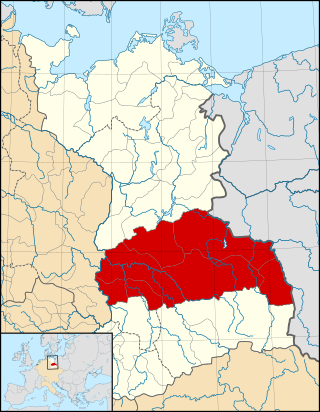
Frederick I, called the Brave or the Bitten was Margrave of Meissen and Landgrave of Thuringia.

Albert II, the Degenerate was a Margrave of Meissen, Landgrave of Thuringia and Count Palatine of Saxony. He was a member of the House of Wettin.

Henry III, called Henry the Illustrious from the House of Wettin was Margrave of Meissen and last Margrave of Lusatia from 1221 until his death; from 1242 also Landgrave of Thuringia.

The Margravate or Margraviate of Meissen was a medieval principality in the area of the modern German state of Saxony. It originally was a frontier march of the Holy Roman Empire, created out of the vast Marca Geronis in 965. Under the rule of the Wettin dynasty, the margravate finally merged with the former Duchy of Saxe-Wittenberg into the Saxon Electorate by 1423.

Waldemar the Great, a member of the House of Ascania, was Margrave of Brandenburg-Stendal from 1308 until his death. He became sole ruler of the Margraviate of Brandenburg upon the death of his cousin John V of Brandenburg-Salzwedel in 1317. Waldemar is known as the last in the line of Ascanian margraves starting with Albert the Bear in 1157; he was only succeeded by his minor cousin Henry II, who died one year later.

The Battle of Lucka occurred on 31 May 1307 near the village of Lucka. The settlement was first mentioned in 1320, but had already existed for around 700 years before that. Lucka is located in the Altenburger Land district of Thuringia.

Landsberg is a town in the Saalekreis in the state of Saxony-Anhalt, Germany

The Saxon Eastern March was a march of the Holy Roman Empire from the 10th until the 12th century. The term "eastern march" stems from the Latin term marchia Orientalis and originally could refer to either a march created on the eastern frontier of the East Frankish duchy of Saxony or another on the eastern border of the Duchy of Bavaria: the Bavarian marchia Orientalis, corresponding to later Austria.
Conrad I, called the Great, a member of the House of Wettin, was Margrave of Meissen from 1123 and Margrave of Lusatia from 1136 until his retirement in 1156. Initially a Saxon count, he became the ruler over large Imperial estates in the Eastern March and progenitor of the Saxon electors and kings.

The March or Margraviate of Lusatia was an eastern border march of the Holy Roman Empire in the lands settled by Polabian Slavs. It arose in 965 in the course of the partition of the vast Marca Geronis. Ruled by several Saxon margravial dynasties, among them the House of Wettin, the lordship was contested by the Polish kings as well as by the Ascanian margraves of Brandenburg. The remaining territory was finally incorporated into the Lands of the Bohemian Crown in 1367.

Theodoric I, a member of the House of Wettin, was Margrave of Lusatia from 1156 until his death.
Otto II, the Rich, a member of the House of Wettin, was Margrave of Meissen from 1156 until his death.
Theodoric of Landsberg, a member of the House of Wettin was Margrave of Landsberg from 1265 until his death.

John I, Margrave of Brandenburg was from 1220 until his death Margrave of Brandenburg, jointly with his brother Otto III "the Pious".

Albert I, called the Proud, a member of the House of Wettin, was the Margrave of Meissen from 1190 until his death.
Margrave Henry I was a member of the House of Ascania and Margrave of Brandenburg-Stendal and Landsberg.
Frederick Tuta, a member of the House of Wettin, was Margrave of Landsberg from 1285 and Margrave of Lusatia from 1288 until his death. He also served as regent of the Margraviate of Meissen.
Margrave Conrad II of Lusatia, also known as Margrave Konrad II of Landsberg, was a member of the House of Wettin. He was Count of Eilenburg and Margrave of Lusatia from 1190 until his death. From 1207, he was also Count of Groitz and Count of Sommerschenburg. He was a son of Margrave Dedi III and his wife, Matilda of Heinsberg, the heiress of Sommerschenburg.
Theodoric IV, Landgrave of Lusatia, also called in German Diezmann, or Dietrich III was a member of the House of Wettin. He was Margrave of Lusatia from 1291 to 1303. He was also Margrave of Osterland from 1291 until his death, and Landgrave of Thuringia, as Dietrich I, from 1298 until his death.














